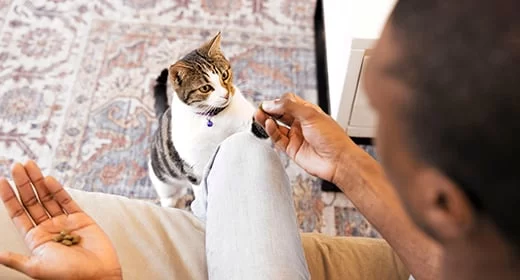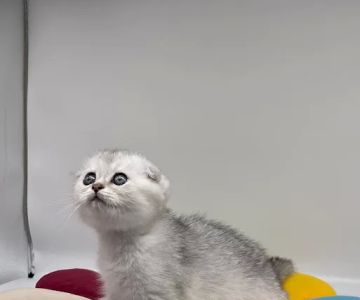The Joy and Challenge of Potty Training Kittens
As a kitten owner, one of the first things I worried about was potty training. Like many other pet owners, I wanted to ensure that my kitten quickly learned how to use the litter box and didn’t make a mess around the house. Over time, I discovered that potty training kittens isn’t as daunting as it may seem, and it can be a fun and rewarding experience for both you and your new furry friend. In this article, I’ll share my personal experience and provide helpful tips for potty training your kitten with ease.
Why Is Potty Training Important for Kittens?
When I first brought my kitten home, I quickly realized that potty training was a crucial part of getting them settled in. Without proper training, your kitten might have accidents around the house, leading to frustration for both you and your pet. Potty training helps establish good habits and promotes cleanliness in your home. Plus, it’s essential for your kitten's overall well-being and comfort to have a designated spot for them to go to the bathroom.
1. Start with the Right Litter Box Setup
One of the most important aspects of potty training a kitten is making sure they have access to the right kind of litter box. I learned this early on when I tried to use a large litter box for my kitten, only to find that she was too small to climb into it easily. The key is to choose a litter box that is appropriately sized for your kitten, allowing them to easily enter and exit. Here’s how to set up the perfect litter box for your kitten:
Choosing the Right Litter Box
There are many types of litter boxes, and selecting the right one can make all the difference in your kitten’s potty training. At first, I went for a shallow, low-sided box to make it easier for my kitten to access. I also found that a box with one side lower than the others worked great, as it gave my kitten easy access while still offering enough room for them to move around comfortably. Make sure the box is clean and placed in a quiet, low-traffic area of your home where your kitten can feel safe using it.
The Best Type of Litter
When it comes to the litter itself, I tried a few different kinds before settling on a clumping, unscented option. I found that clumping litter made it easier to keep the box clean and helped my kitten get used to the idea of burying waste. Unscented litter was a better choice as kittens have sensitive noses, and strongly scented litters can be overwhelming. Choose a litter that’s comfortable for your kitten to walk in, and make sure to keep the box clean by scooping it at least once a day.
2. Show Your Kitten Where the Litter Box Is
One mistake I made initially was assuming my kitten would just instinctively know where the litter box was. However, I quickly learned that kittens need guidance to understand where to go. After bringing my kitten home, I gently placed her in the litter box several times a day, especially after meals and naps when they’re more likely to need to go. Every time she was placed in the litter box, I made sure to praise her for being in the right spot. Positive reinforcement went a long way in helping her understand where she was supposed to go.
Consistency is Key
Consistency is essential when potty training a kitten. I always made sure to place her in the litter box after playtime or meals, as these are the times when kittens are most likely to need to use the bathroom. Over time, she learned to associate the litter box with going to the bathroom, and it became second nature to her. If your kitten has an accident outside the box, don’t scold them; simply clean up the mess and place them back in the litter box. Patience and consistency are the best tools for success.
3. Be Patient and Understanding
Potty training a kitten is a gradual process that requires a lot of patience. When I first started training my kitten, I noticed she would sometimes forget and have accidents in other parts of the house. I realized that kittens are still learning and developing their coordination, so occasional accidents are normal. The key is not to get frustrated but to offer encouragement and keep guiding them to the litter box. Over time, your kitten will get better at recognizing the appropriate place to go.
When to Expect Progress
Most kittens start getting the hang of using the litter box after a few weeks of consistent training. During this time, you may notice that your kitten will start using the box on their own more frequently. For me, the turning point came when my kitten began walking straight to the litter box without any prompting. While accidents may still happen from time to time, the process of potty training was overall much easier than I had anticipated.
4. Troubleshooting Common Potty Training Issues
While potty training is generally straightforward, there are a few common issues you may encounter. Don’t worry if you face these challenges—many pet owners experience them, and they can usually be resolved with a little patience and adjustment. Here are some common potty training problems I ran into and how I handled them:
Kitten Not Using the Litter Box
If your kitten isn’t using the litter box, it might be because the box is too dirty, in the wrong location, or not to their liking. I found that keeping the box clean and placing it in a quiet, safe area really helped encourage my kitten to use it. If your kitten is still avoiding the box, try changing the type of litter you’re using or ensuring that the box is the right size.
Accidents Outside the Box
Occasional accidents are completely normal during the potty training process. I never punished my kitten for having an accident. Instead, I focused on cleaning up thoroughly and placing her in the litter box more frequently. Positive reinforcement when she did use the litter box worked wonders in helping her learn the right behavior.
5. Transitioning to a Larger Litter Box
As my kitten grew, I had to transition her to a larger litter box. This was another adjustment that required a bit of patience, as she had to get used to a bigger space. However, once she did, it became even easier for her to use the box without any problems. I recommend gradually transitioning your kitten to a bigger box as they grow to avoid any confusion or accidents during the switch.
Potty training your kitten doesn’t have to be a stressful experience. With the right setup, patience, and consistency, you can help your kitten learn how to use the litter box successfully. It’s all about understanding their needs, providing positive reinforcement, and guiding them through the process step by step. I’m confident that with these tips, your kitten will soon become a pro at using the litter box!












